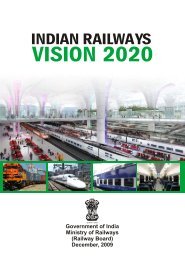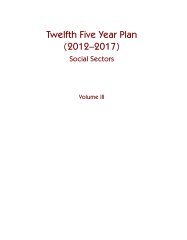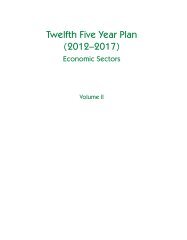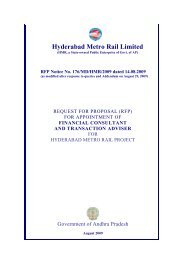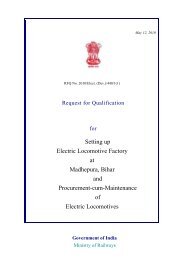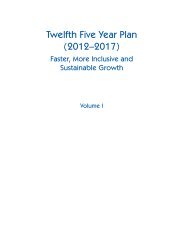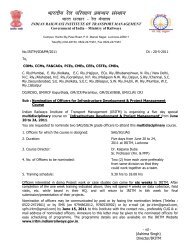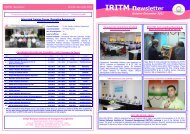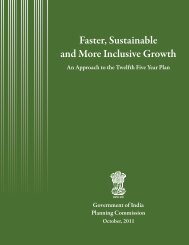Approach 12 FYP - Indian Railways Institute of Transport Management
Approach 12 FYP - Indian Railways Institute of Transport Management
Approach 12 FYP - Indian Railways Institute of Transport Management
Create successful ePaper yourself
Turn your PDF publications into a flip-book with our unique Google optimized e-Paper software.
10 <strong>Approach</strong> to the Twelfth Five Year Plan<br />
1.37 Rational energy pricing is critical for both effective demand management and a healthy supply<br />
response. It is relevant for demand management, because energy users have no incentive to economize<br />
if energy is under-priced. It is also relevant for expansion <strong>of</strong> domestic supply, because under-pricing<br />
<strong>of</strong> energy imposes a large burden on the energy producers reducing the resources that should accrue<br />
to them for financing new investments in these areas. In the longer term, we must move beyond<br />
fossil fuels to non-conventional energy. However, these new energy sources are significantly more<br />
expensive at present than fossil fuels and increased dependence on these fuels will mean higher per<br />
unit energy costs.<br />
1.38 The Integrated Energy Policy, which was approved in 2009, had enunciated principles <strong>of</strong> energy<br />
pricing that equalize domestic energy prices with the prices <strong>of</strong> imported energy, while allowing for<br />
targeted subsidy to the needy and poor. While we have taken some steps in this direction, our energy<br />
prices still remain significantly below the world prices. This is true for both petroleum prices (other than<br />
petrol) and coal. It is also true <strong>of</strong> electricity, since regulators, <strong>of</strong>ten under political pressure, are not setting<br />
tariffs to reflect normative costs. The Twelfth Plan must address the challenge <strong>of</strong> aligning domestic energy<br />
prices with the global price trends. This is not easy to do in a short time span, but it can be done gradually<br />
over a period <strong>of</strong> time. It must be emphasized that our ability to sustain high growth in the Twelfth Plan<br />
will depend critically upon our ability to make this adjustment. The poor will need subsidy, which should<br />
be appropriately targeted, but energy prices in general cannot be de-linked from global price levels,<br />
particularly in a situation where import dependence is increasing.<br />
Natural Resource <strong>Management</strong> – Water, Land and Forests<br />
1.39 Economic development will be sustainable only if it is pursued in a manner which protects the<br />
environment. With acceleration <strong>of</strong> economic growth, these pressures are expected to intensify, and we<br />
therefore, need to pay greater attention to the management <strong>of</strong> water, forests and land.<br />
1.40 <strong>Management</strong> <strong>of</strong> water resources poses increasingly difficult challenges that will require attention<br />
in the Twelfth Plan. The total quantity <strong>of</strong> usable fresh water annually available in India is fixed, but its<br />
demand from expanding agriculture and other sectors is increasing. Water resources in many parts <strong>of</strong> the<br />
country are under severe stress leading to excessive exploitation <strong>of</strong> ground water. There is some scope for<br />
increasing water availability. While these opportunities must be fully exploited, the real solution has to<br />
come from greater efficiency in water use.<br />
1.41 Agriculture accounts for 80.0 per cent <strong>of</strong> water needs at present, and there is considerable scope<br />
for increasing efficiency <strong>of</strong> water use in this area. This requires better management <strong>of</strong> water in areas <strong>of</strong><br />
large and medium irrigation projects. It also requires putting in place more holistic aquifer management<br />
strategies. Separation <strong>of</strong> electricity feeders for agriculture and domestic use can help limit the availability<br />
<strong>of</strong> electricity for pumping ground water thus breaking the vicious cycle between free energy and excess<br />
use <strong>of</strong> groundwater. Wherever this has been done in combination with large-scale watershed programmes,<br />
there is evidence that groundwater levels have recovered.<br />
1.42 Normally, efficient use <strong>of</strong> scarce resources requires appropriate pricing, but pricing <strong>of</strong> water is a<br />
sensitive issue. This problem can be solved by providing ‘lifeline’ water supplies for drinking and cooking<br />
at very low prices, while charging appropriately for additional water use by domestic consumers. There is a<br />
stronger case for rational pricing reflecting the scarcity <strong>of</strong> water for commercial and industrial use. There is<br />
also a strong case for rational pricing <strong>of</strong> water for agricultural purposes. The proportion <strong>of</strong> water recycled





